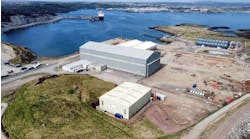Subsea 7, FLASC secure funding for offshore energy storage technology
Subsea 7 and technology partner FLASC B.V. say that they have been awarded a grant from the UK government Department for Business, Energy and Industrial Strategy for £471,760, to further develop an innovative offshore energy storage system.
Funding has been awarded as part of the Longer Duration Energy Storage Competition. The competition recognizes the transition to increasing wind generated renewable energy, which presents growing opportunities for storage systems that support a secure, flexible, and reliable electrical power supply.
The companies say that the PowerBundle concept will combine FLASC’s Hydro-Pneumatic Energy Storage technology and Subsea 7’s subsea pipeline bundle technology, resulting in a scalable and robust offshore energy storage solution.
Subsea Europe Services wins funding to accelerate autonomous survey development
A new round of funding has strengthened hydroacoustic technology specialist Subsea Europe Service GmbH’s commitment to taking autonomous technologies to the next level for marine survey applications.
The investment boosts the company’s unique approach which focuses on the integration of new generation smart, AI, and machine learning-enabled hydroacoustic systems with diverse survey platforms including Autonomous Underwater Vehicles, Unmanned Surface Vessels, and crewed vessels as survey motherships.
Subsea Europe Services is working with several autonomy-focused partners globally and the first fruits of these collaborations will be shown as early as April 2022, during demonstrations of a new solution created with MARTAC Inc., and based on the high-performance Mantas T12 Unmanned Surface Vehicle (USV) with a tightly integrated hydrographic survey payload.
The solution is expected to be ready for operation in May, with short, on-demand surveys at offshore wind farms projected to drive demand for the combination of a high-speed USV and increased autonomous payload functionality.
MAN to supply third subsea compressor for Åsgard offshore mid-Norway
Equinor has ordered another subsea compressor system from MAN Energy Solutions for the Åsgard gas field in the Norwegian Sea.
In 2016, Åsgard became the world’s first subsea gas-compression facility to start operations, at a water depth of 300 m (984 ft).
It features two MAN Subsea HOFIM motor-compressor units which have accumulated 100,000 operational hours without the need for intervention and with an availability said to be close to 100%.
In co-operation with Equinor and Aker Solutions, the existing subsea compression modules are being upgraded to achieve a higher compression ratio, in order to maintain output and enhance recovery as the gas reservoir’s pressure naturally declines.
MAN Energy Solutions will supply an additional HOFIM system with compressor frame size RB 45 and an integrated MAN motor (size M43).
To increase the pressure-ratio capability, the unit will feature a new, overhung compression stage on the opposite side of the motor.
The motor compressor is designed for continuous liquid injection (wet-gas compression). It will be developed, manufactured and tested in Zurich, Switzerland, with delivery planned for March 2023.
Woodside books DOF Subsea to remove Enfield Xmas trees
Woodside Energy has awarded DOF Subsea Australia a contract to perform subsea equipment retrieval at the Enfield field offshore Western Australia.
The campaign will involve recovery of 18 subsea Xmas trees, 18 flowbases and associated spool sections, one wellhead severance, and recovery of up to 18 temporary guide bases.
DOF’s scope includes provision of project management, engineering, fabrication, and decommissioning services. The work is due to take place during Q3 and Q4 2022, using the MPSV Skandi Hercules.
Verlume developing power systems for subsea inspection robot
Verlume has provided an update on the RoboFish development, an autonomous underwater robot designed to move like a fish for offshore inspection tasks.
The ‘biomimetic’ autonomous underwater vehicle (AUV), named RoboFish, comprises various modules with self-managed battery and actuator control for full-body, autonomous movement around underwater structures.
Researchers at the University of York’s Department of Electrical Engineering and the University of Strathclyde’s Department of Naval Architecture, Ocean & Marine Engineering devised the initial system., with support from the EPSRC Supergen Offshore Renewable Energy Hub.
According to Verlume, the limited accessibility, maneuverability and environmental impact of ROVs and some larger AUVs makes inspection of subsea structures complex, costly, and reliant on human input.
As offshore wind developments lead to rapid growth in offshore structures, robotic offshore inspections in harsh environments will need to become more autonomous and more cost-effective, the company added.
The initial RoboFish research consortium comprised Verlume, the two universities, PicSea, the Supergen ORE Hub, and the Offshore Renewable Energy Catapult and membership is now expanding.
The first prototype was completed in summer 2020 and work continues on improvements and new applications.
Verlume is developing an intelligent power system for charging RoboFish, and an intelligent battery management system, both designed for reliable, uninterrupted power supply on the seabed.




